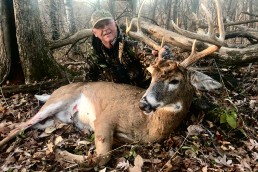Deer Calling Tricks and Tips
SHARE THIS POST
Many novice bowhunters have mistakenly gotten the idea that more and larger deer calls equates to more and larger bucks. Contrarily, Joe Bucher says they might even hurt your chances if not employed properly.
How often, how loud, and how much you should call varies a great deal from one day to the next, and certainly changes throughout the fall season. For example, early fall hunts often suggest softer calling with long quiet spells. In fact, many bowhunters don’t call much, if at all, at this time of year. Yet in some regions, trail cam photos clearly show sparring matches with surprising regularity as soon as a buck’s antlers harden, and velvet disappears. By the way, trail cam evidence of increased buck sparring is a clear indication to ramp up rattling, as well as grunt calling, no matter what the calendar says.
Admittedly, before my obsession with trail cam placement and observations of buck behavior, I used to hold off on using rattling tactics until far later in the season. This also includes the making of mock scrapes and the reliance of scrapes in hunting strategy. In the past, I wouldn’t even carry rattling antlers until late October, nor consider hunting over a scrape. Trail cam evidence has changed all that. Now, I have my “horns” (rattling antlers) with me on nearly every hunt. And I hunt near traditional year ‘round licking branches, which are also communal scrapes, even in September.
Wind velocity and subsequent branch and leaf noise obviously has a bearing on the effectiveness of any calling attempts on any given hunt. It also affects the overall duration of active deer movement on both morning and evening hunts before the rut. Generally, when it is quiet, calling works better simply because deer are more likely to hear it. A loud and noisy woods swallows up sound, canceling out the tone of a grunt call or the clack and clang of antlers.
Bucks are sure to still spar during windy weather, but it is doubtful they will hear a distant grunt or antler clash. Therefore, I do very little calling in windy conditions. However, any afternoon hunt with a noticeable drop in wind velocity near or just after sunset can be magic time for rattling and grunting.
The intensity of rattling attempts early in the season usually involves light to moderate intervals matching the behavior of buck sparring at that time. As the rut intensifies towards late October, more intense sparring and even all-out fighting matches are likely to occur. Your rattling technique should mock this attitude with longer rattling sequences and a heavier meshing and crashing of antlers.
Bucks tend to grunt naturally in a variety of situations throughout the fall, but their vocalizations increase toward the end of October for sure. They nearly always grunt a bit when working a scrape and licking branches, and some serious buck grunting is bound to occur when working a large tree rub. I’ve also watched bucks grunt when on the move towards another deer.
Are you enjoying this post?
You can be among the first to get the latest info on where to go, what to use and how to use it!
This validates the necessity to occasionally “blind call” with your grunter. If you hear a distant grunt or observe a long-range buck hitting a licking branch or rubbing a tree, hitting him with a grunt call is apt to bring him into range to investigate the rival.
The grunt call is also effective at luring a traveling buck you can see from a distance. Anytime you spot a buck cruising out of shot range, a quick hit from your grunt call is likely to stop him and maybe draw him towards you. However, never blow on a grunt call when a buck is facing you. You do not want that deer to pinpoint your exact location.
The same can be said for rattling procedures. If you see a buck traveling by out of range, a quick “tickle” will likely get him to stop, turn, look and listen. Do not continue to rattle while he’s facing you. But as soon as his head turns away, hit the antlers again quickly.
The new doe and/or fawn bleat “can calls” are also very effective at times. In fact, I think they are more effective at calling does than bucks. But occasionally, they even attract bucks, particularly during the rut peak.
Finally, the latest calling rage involves “the wheeze.” The wheeze, or grunt/snort/wheeze as some like to call it, essentially imitates a rarely heard vocal posture of more dominant mature bucks. Better than 75 percent of the time, you are bound to get a negative reaction from the wheeze call on a small buck. Yet a truly mature buck is apt to bristle up all the hairs on his back, turn towards you and stomp right in.
If you want to learn more about the tools and gear that can help improve your hunting this fall, read the fall issues of MidWest Outdoors, available by subscribing on our website.
MWO
SHARE THIS POST
You may also like...
Nothing found.
Did you enjoy this post?
You can be among the first to get the latest info on where to go, what to use and how to use it!
Joe Bucher
Joe Bucher is a Freshwater Fishing Hall of Fame Legendary Angler, book author, lure designer and host of Fishing with Joe Bucher TV series.
